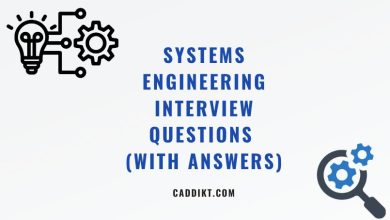Electrical engineering is a dynamic field that encompasses a wide range of knowledge and skills. Aspiring electrical engineers often face rigorous interview processes to showcase their expertise and secure job opportunities. To help you prepare for your electrical engineering interviews, we have compiled a list of 50 common interview questions along with their answers. In this article, we will cover various topics, including fundamental concepts, circuit analysis, power systems, control systems, electronics, and more. By familiarizing yourself with these questions and understanding their underlying principles, you can confidently approach your interviews and demonstrate your competence in the field of electrical engineering.
Top Interview Questions about Electrical Engineering
1. What is electrical engineering?
Electrical engineering is a field of engineering that deals with the study, design, and application of electrical systems and devices. It involves the generation, transmission, and utilization of electrical energy for various purposes.
2. What are the fundamental components of an electrical circuit?
The fundamental components of an electrical circuit include a voltage source, such as a battery or power supply, conductors (wires) to carry the current, resistors to control the flow of current, capacitors to store electrical charge, inductors to store energy in a magnetic field, and switches to control the circuit.
3. What is Ohm’s Law?
Ohm’s Law states that the current flowing through a conductor between two points is directly proportional to the voltage across the two points, and inversely proportional to the resistance of the conductor. It can be expressed as I = V/R, where I is the current, V is the voltage, and R is the resistance.
4. How is power calculated in an electrical circuit?
Power in an electrical circuit can be calculated using the formula P = VI, where P is the power in watts, V is the voltage in volts, and I is the current in amperes. Alternatively, it can be calculated as P = I^2R or P = V^2/R, using Ohm’s Law.
5. What is the difference between AC and DC circuits?
AC stands for alternating current, while DC stands for direct current. The main difference between AC and DC circuits is the direction of the flow of electric charge. In AC circuits, the flow of charge periodically reverses direction, while in DC circuits, the flow of charge is unidirectional.
6. What is the purpose of a transformer?
A transformer is used to transfer electrical energy between two or more circuits through electromagnetic induction. It can step up or step down the voltage levels of an AC electrical signal while maintaining the same frequency.
7. How do you calculate the voltage drop in a circuit?
The voltage drop in a circuit can be calculated using Ohm’s Law. It is given by the formula V = IR, where V is the voltage drop, I is the current flowing through the circuit, and R is the resistance of the circuit component.
8. What is the difference between resistance and impedance?
Resistance refers to the opposition of a material or component to the flow of electric current. It is typically encountered in DC circuits. Impedance, on the other hand, refers to the combined effect of resistance and reactance (which includes inductive and capacitive effects) in an AC circuit.
9. What is the concept of grounding in electrical systems?
Grounding is a safety measure used in electrical systems to provide a direct path for electrical current to flow into the earth in case of a fault. It helps prevent electric shock, reduces electrical noise, and provides a reference point for voltage measurements.
10. What is the role of capacitors in electronic circuits?
Capacitors are passive electronic components used to store and release electrical energy in an electrical field. They can block DC and allow AC to pass through, store energy for timing and filtering applications, stabilize voltage levels, and act as coupling devices between different parts of a circuit.
11. What is the purpose of diodes in electrical circuits?
Diodes are semiconductor devices that allow current to flow in only one direction. They are commonly used in electrical circuits as rectifiers to convert AC to DC, protect components from reverse voltage damage, and control the direction of current flow in various applications such as signal demodulation and power regulation.
12. What are the different types of electric motors?
There are several types of electric motors, including DC motors, induction motors, synchronous motors, stepper motors, and brushless DC motors. Each type has its own characteristics and applications. DC motors are commonly used in household appliances and automotive applications, while induction motors are widely used in industrial and commercial systems.
13. How does an induction motor work?
An induction motor operates on the principle of electromagnetic induction. It consists of a stator, which contains windings that create a rotating magnetic field when supplied with AC power, and a rotor, which is either wound with conductors or consists of squirrel cage bars. The rotating magnetic field induces currents in the rotor, producing a torque that causes the motor to rotate.
14. What is a relay and how does it work?
A relay is an electromagnetic switch used to control the flow of electrical current in a circuit. It consists of an electromagnet and a set of contacts. When a current is applied to the electromagnet, it generates a magnetic field that attracts or releases the contacts, thereby opening or closing the circuit. Relays are commonly used in automation, control systems, and electrical protection.
15. What is the difference between a fuse and a circuit breaker?
A fuse and a circuit breaker are both protective devices used to interrupt the flow of current in a circuit under abnormal or overload conditions. The main difference is their operation and resetability. A fuse contains a metal element that melts when current exceeds a certain threshold, permanently breaking the circuit. A circuit breaker, on the other hand, uses a switch mechanism that can be manually or automatically tripped to open the circuit, and it can be reset after the fault is cleared.
16. What is the function of a transistor?
A transistor is a semiconductor device that amplifies or switches electronic signals and electrical power. It consists of three layers of semiconductor material and can be configured as a current amplifier (in common emitter, common collector, or common base configurations) or as a switch (on or off state controlled by a small input current or voltage). Transistors are key components in electronic circuits and play a crucial role in digital logic gates, amplifiers, and other electronic systems.
17. What are the different types of semiconductor materials?
There are two main types of semiconductor materials: intrinsic and extrinsic. Intrinsic semiconductors, such as pure silicon and germanium, have a balanced number of electrons and holes at room temperature. Extrinsic semiconductors are doped with impurities to modify their electrical properties. N-type semiconductors are doped with impurities that introduce additional electrons, while P-type semiconductors are doped with impurities that create additional holes.
18. What is the significance of Kirchhoff’s laws?
Kirchhoff’s laws are fundamental principles used in analyzing electrical circuits. Kirchhoff’s current law (KCL) states that the algebraic sum of currents entering and exiting a node in a circuit is zero. Kirchhoff’s voltage law (KVL) states that the algebraic sum of voltages around any closed loop in a circuit is zero. These laws provide a systematic approach to solving complex circuits and are essential for circuit analysis and design.
19. What is the purpose of a feedback system in control engineering?
A feedback system in control engineering is used to monitor and adjust the behavior of a system based on its output. It provides information about the system’s performance and allows for corrective measures to be taken. Feedback systems help maintain stability, improve accuracy, and achieve desired performance in control systems, such as in industrial automation, robotics, and process control.
20. What is the concept of resonance in electrical circuits?
Resonance in electrical circuits occurs when the frequency of an applied AC signal matches the natural frequency of the circuit. At resonance, the circuit exhibits a maximum response, and energy transfer between the source and the circuit is most efficient. Resonance phenomena are utilized in various applications, including filters, tuning circuits, and wireless communication systems.
21. How are electrical power systems classified?
Electrical power systems can be classified into various categories based on factors such as the source of power generation, the frequency of the AC supply, and the type of distribution. Common classifications include utility power systems, industrial power systems, residential power systems, and off-grid power systems (such as solar or wind power systems).
22. What is a synchronous generator and how does it work?
A synchronous generator is a device that converts mechanical energy into electrical energy. It operates on the principle of electromagnetic induction and consists of a rotor and a stator. The rotor, driven by a prime mover (such as a steam turbine or a water turbine), rotates at a synchronous speed that matches the frequency of the AC power system. The rotating magnetic field induces a voltage in the stator windings, generating electrical power.
23. What are the advantages and disadvantages of three-phase power systems?
Three-phase power systems offer several advantages over single-phase systems. These include higher power transmission capacity, balanced power delivery, efficient motor operation, and reduced conductor size. However, three-phase systems require additional equipment and complexity compared to single-phase systems. Installation and maintenance costs can be higher, and not all applications require the higher power capacity provided by three-phase systems.
24. What is the role of a capacitor in power factor correction?
A capacitor is used in power factor correction to improve the power factor of an AC electrical system. The power factor is a measure of how effectively the system utilizes the supplied power. Capacitors connected in parallel with inductive loads, such as motors or transformers, help to offset the reactive power component and bring the power factor closer to unity. This improves the overall efficiency of the system, reduces energy losses, and can result in cost savings.
25. How does a variable frequency drive work?
A variable frequency drive (VFD), also known as an adjustable speed drive, is an electronic device used to control the speed of AC electric motors by varying the frequency of the supplied power. It converts the fixed-frequency AC power into a variable frequency and voltage output. By adjusting the frequency and voltage, the VFD can regulate the motor speed, allowing for energy savings, precise control, and improved motor performance in various applications.
26. What is the difference between a sensor and a transducer?
A sensor is a device that detects and responds to a physical stimulus, such as light, temperature, pressure, or motion, and converts it into an electrical signal. A transducer, on the other hand, is a broader term that encompasses devices used to convert one form of energy into another. While all sensors are transducers, not all transducers are sensors. Transducers can also convert energy from electrical to mechanical, thermal, or other forms.
27. What is the concept of modulation in communication systems?
Modulation is the process of modifying a carrier signal, typically a high-frequency wave, by encoding information onto it. This is done to facilitate the transmission of the information over long distances or through different mediums. Modulation techniques, such as amplitude modulation (AM), frequency modulation (FM), and phase modulation (PM), allow for the efficient transmission of signals in various communication systems, including radio, television, and telecommunications.
28. What is the purpose of a rectifier in a power supply?
A rectifier is used to convert alternating current (AC) into direct current (DC) in a power supply. It consists of diodes arranged in a specific configuration to allow the flow of current in only one direction. The rectifier rectifies the AC voltage, removing the negative portion of the waveform, and provides a steady DC output that can be used to power electronic devices and circuits.
29. What is the concept of harmonics in electrical systems?
Harmonics are electrical voltages or currents that have frequencies that are integer multiples of the fundamental frequency in an AC power system. They are caused by nonlinear loads, such as electronic devices and equipment, which introduce distortion into the power system. Harmonics can lead to issues such as increased losses, overheating of equipment, and interference with sensitive devices. Mitigation techniques, such as harmonic filters and proper equipment design, are employed to minimize the impact of harmonics.
30. What are the different types of electrical transients?
Electrical transients, also known as voltage or current surges, are brief fluctuations in the electrical system that can have high amplitudes and short durations. There are several types of transients, including switching transients (caused by switching operations), lightning transients (caused by lightning strikes), and load transients (caused by sudden changes in load conditions). Transients can cause equipment damage, data loss, and system instability. Surge protection devices, such as surge suppressors and voltage regulators, are used to mitigate the effects of transients.
31. What is the difference between analog and digital signals?
Analog signals are continuous, varying signals that represent real-world quantities with infinite possible values. They can take on any value within a given range. Digital signals, on the other hand, are discrete signals that represent information using a series of binary values (0s and 1s). Digital signals have a finite set of values and are more resistant to noise and distortion compared to analog signals. They are commonly used in computers, telecommunications, and digital electronics.
32. What is the role of an operational amplifier (op-amp)?
An operational amplifier, or op-amp, is a high-gain electronic amplifier with two inputs and one output. It is widely used in analog circuit design and performs various functions, including amplification, filtering, voltage offset compensation, and signal conditioning. Op-amps are versatile components and are key building blocks in many electronic circuits, such as amplifiers, filters, oscillators, and instrumentation systems.
33. How does a digital-to-analog converter (DAC) work?
A digital-to-analog converter (DAC) is a device that converts digital signals, typically binary numbers, into analog signals. It takes a digital input and produces a continuous analog output that represents the digital information. This is achieved through various techniques, such as pulse width modulation (PWM), sigma-delta modulation, or resistor ladder networks. DACs are used in audio systems, telecommunications, measurement equipment, and other applications where digital signals need to be converted to analog for processing or output.
34. What is the purpose of a voltage regulator in electronic circuits?
A voltage regulator is used to maintain a constant voltage level in an electronic circuit despite changes in input voltage or load conditions. It ensures that the output voltage remains stable and within specified limits, providing reliable and consistent power to sensitive components. Voltage regulators are commonly used in power supplies, microcontrollers, integrated circuits, and other electronic devices that require precise and regulated voltage levels.
35. What is the concept of power factor in AC circuits?
Power factor is a measure of how effectively electrical power is being utilized in an AC circuit. It represents the ratio of real power (in watts) to apparent power (in volt-amperes). Power factor can range from 0 to 1, with a higher power factor indicating more efficient power usage. A low power factor is typically caused by reactive loads, such as motors or capacitive/inductive elements, and can result in increased energy consumption, reduced system efficiency, and additional costs. Power factor correction techniques, such as adding capacitors or employing active power factor correction circuits, are used to improve power factor and optimize energy usage.
36. How is power transmitted over long distances?
Power is transmitted over long distances using high-voltage AC transmission lines. The use of high voltage allows for reduced current levels, which minimizes power losses due to resistance. The power generated at the source, such as a power plant, is stepped up to high voltage using transformers. The high-voltage electricity is then transmitted through overhead lines or underground cables. Along the transmission path, substations are used to step down the voltage for distribution to local areas. This process of stepping up and stepping down voltages ensures efficient power transmission over long distances with minimal losses.
37. What is the principle behind electromagnetic induction?
Electromagnetic induction is the process by which a changing magnetic field induces an electromotive force (EMF) in a conductor. It is based on Faraday’s law of electromagnetic induction. When there is relative motion between a magnetic field and a conductor or a change in the magnetic field strength, an EMF is induced in the conductor. This phenomenon forms the basis of many electrical devices, such as generators, transformers, and induction motors.
38. What is the difference between a sensor and an actuator?
A sensor is a device that detects and measures physical or environmental parameters, such as temperature, pressure, light, or motion. It converts the measured quantity into an electrical signal that can be processed or used for control purposes. An actuator, on the other hand, is a device that receives a control signal and converts it into physical action. Actuators are responsible for initiating a desired mechanical, electrical, or thermal response based on the input signal from a control system. Sensors and actuators often work together in feedback control systems to sense the environment and act upon it.
39. What is the concept of hysteresis in magnetic materials?
Hysteresis in magnetic materials refers to the lagging or delayed response of the material’s magnetization to changes in the applied magnetic field. When a magnetic material is subjected to an increasing or decreasing magnetic field, its magnetization does not immediately align with the field. Instead, it follows a path that forms a closed loop known as a hysteresis loop. Hysteresis can be observed in ferromagnetic materials and is important in applications such as magnetic storage devices, transformers, and magnetic sensors.
40. What is the role of a microcontroller in embedded systems?
A microcontroller is a small, integrated circuit that contains a processor, memory, and input/output peripherals on a single chip. It serves as the brain of an embedded system, providing control and processing capabilities. Microcontrollers are designed for specific tasks and are commonly used in various applications, such as home automation, automotive systems, industrial control, and consumer electronics. They can execute pre-programmed instructions and interact with external devices to perform specific functions and tasks.
41. What is the purpose of a voltage multiplier circuit?
A voltage multiplier circuit is used to increase the voltage level from a lower input voltage. It achieves this by using a combination of diodes and capacitors to charge and discharge capacitors in a series-parallel configuration. The voltage multiplier circuit is often used in applications where a high voltage is required, such as cathode-ray tubes (CRTs), electrostatic precipitators, and voltage multipliers for electronic experiments or high-voltage power supplies.
42. What are the different types of electrically conductive materials?
There are several types of electrically conductive materials, including metals, conductive polymers, and certain types of carbon materials. Metals, such as copper, aluminum, and silver, are widely used for their excellent conductivity. Conductive polymers, made from organic compounds, offer unique properties such as flexibility and light weight. Carbon materials, such as graphite and carbon nanotubes, also exhibit conductivity and find applications in various electronic devices and systems.
43. How are electrical faults detected and protected against?
Electrical faults can be detected using various methods, including protective relays, circuit breakers, and ground fault detectors. Protective relays continuously monitor electrical parameters such as current, voltage, and frequency to detect abnormal conditions or faults. When a fault is detected, circuit breakers are tripped, isolating the faulty section from the rest of the system. Ground fault detectors monitor for current imbalances between the supply and the ground, providing protection against shock hazards. These measures help prevent damage to equipment, ensure personnel safety, and maintain system reliability.
44. What is the principle behind photovoltaic (solar) cells?
Photovoltaic (solar) cells operate based on the principle of the photovoltaic effect. When certain semiconductor materials, typically silicon, are exposed to sunlight, the energy from photons in the sunlight is absorbed by the material. This generates electron-hole pairs, creating a voltage potential across the material. By connecting multiple solar cells together, it is possible to generate a usable electrical current. This conversion of sunlight directly into electrical energy forms the basis of solar power generation.
45. What is the difference between a multiplexer and a demultiplexer?
A multiplexer (MUX) is a device that allows multiple input signals to be transmitted over a single transmission line by selecting and combining the signals into a single output. It is often used in communication systems and digital electronics. A demultiplexer (DEMUX), on the other hand, performs the reverse operation. It takes a single input and routes it to one of several output lines based on control signals. Demultiplexers are commonly used to distribute a single input signal to multiple destinations in a circuit or system.
46. What is the concept of time-domain and frequency-domain analysis?
Time-domain analysis involves the study of signals or systems in the time domain. It focuses on the behavior and characteristics of signals or systems as a function of time. Time-domain analysis provides information about signal amplitude, duration, and timing relationships. On the other hand, frequency-domain analysis involves the study of signals or systems in the frequency domain. It examines the signal’s frequency content and how it is affected by different frequency components. Frequency-domain analysis, often performed using techniques such as Fourier analysis, provides information about signal spectrum, frequency response, and filtering characteristics.
47. How does a digital signal processor (DSP) work?
A digital signal processor (DSP) is a specialized microprocessor designed to efficiently process and manipulate digital signals in real-time. It utilizes mathematical algorithms and dedicated hardware to perform tasks such as filtering, modulation, demodulation, compression, and other signal processing operations. DSPs excel in handling repetitive and computationally intensive tasks, making them suitable for applications such as audio and video processing, telecommunications, control systems, and digital image processing.
48. What is the purpose of a power supply filter?
A power supply filter is used to remove or reduce unwanted noise and ripple from the output of a power supply. When an AC voltage is rectified to DC, there can be residual AC components and fluctuations, known as ripple, present in the output. The power supply filter, often in the form of capacitors and inductors, smooths out the DC voltage, filtering out the ripple and ensuring a more stable and regulated power supply. This is crucial in electronic circuits where clean and stable power is necessary for proper operation of components and avoiding interference or malfunctions.
49. What is the role of a flyback transformer in power supplies?
A flyback transformer is a specialized type of transformer used in power supplies, particularly in switch-mode power supplies (SMPS). It operates on the principle of energy storage and transfer. The flyback transformer stores energy in its magnetic field during the on-time of a switching transistor and releases it during the off-time. This allows for efficient energy transfer and voltage conversion in SMPS, enabling the generation of multiple output voltages from a single input voltage. The flyback transformer also provides isolation between the input and output sections of the power supply, ensuring safety and proper functioning of the circuit.
50. How are electrical signals transmitted through optical fibers?
Electrical signals are transmitted through optical fibers using a process called optical communication. In this process, electrical signals are converted into optical signals using a transmitter, typically a laser or an LED. The optical signals, consisting of light pulses, are then transmitted through the core of the optical fiber via total internal reflection. The core of the fiber is made of a highly transparent material, such as glass or plastic, which guides the light along its length. At the receiving end, a photodetector converts the optical signals back into electrical signals. Optical fiber communication offers high data transfer rates, low signal loss, and immunity to electromagnetic interference, making it suitable for long-distance telecommunications and high-speed data transmission.
Conclusion
electrical engineering interviews can be challenging, but with thorough preparation and understanding of the fundamental concepts, you can increase your chances of success. This article has provided you with a comprehensive list of 50 interview questions and their answers, covering a wide range of topics in electrical engineering. Remember to not only memorize the answers but also grasp the underlying principles behind them. Additionally, practice explaining complex concepts in a clear and concise manner. By combining technical knowledge with effective communication skills, you can impress interviewers and showcase your potential as an electrical engineer. Best of luck in your interviews and your future career in electrical engineering!
Note: It is important to note that interview questions may vary depending on the specific company or organization conducting the interview. Therefore, it is advisable to research and prepare for company-specific questions in addition to the ones mentioned in this article.










